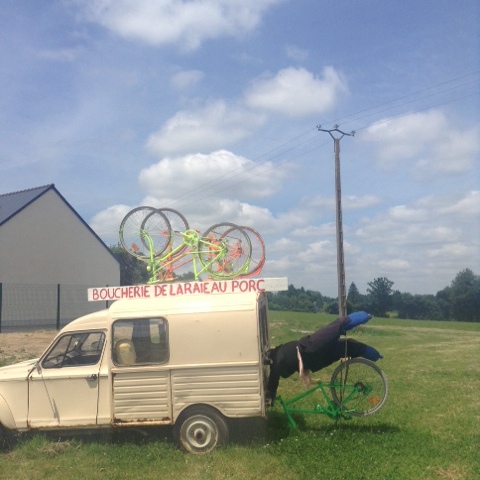As I pedaled squares on the climb, I was scanning the road side for a monument honoring Robic for his heroic feat, upholding French honor winning the first post-War Tour and sparing the country the ignominy of an Italian winning the race. It was years before French resentment towards Italy subsided. One subsequent year the Italians pulled out of the race en masse accusing the French fans along the roadside of attacking them.
I knew what the monument looked like, but I didn't know its location. I had failed to find it a year ago, thinking it was a mere plaque, and unable to find a soul late in the day who knew anything about it as I recounted in the post “Robic Who” of June 11. Now I knew it was a large marble slab with an image of Robic. I figured it would be easy to spot. I had been told at Rouen's tourist office that it might be on one of several switchbacks on a narrow super-steep road that turned off the main climb. When I reached the summit of that climb without spotting it, I assumed it must be in the small park at the summit. Not so. A man walking his dog told me it was back on the main road near the summit.
Fortunately I didn't have to descend the road I had just come up, as I now was on a plateau overlooking Rouen and the Seine, and could simply swing over to the other road. I began its descent with hands on brakes keeping my speed to a minimum as I looked for the monument. Still it was not to be seen. After I had plunged about a third of the way down I came to a forest with a path entering it. I stopped to see if it might lead to the monument. Thwarted again. I asked the next person I saw where it might be. He said it was back up the road on the right hand side just before a bakery. I had missed it because it was overgrown with vegetation and could only be seen as one came up the climb.
I had to trim away a bunch of branches to be able to read the inscription on the monument in its entirety.
There was no mention that Robic rode The Tour nine more times and never finished higher than fourth or fifth and failed to complete The Race his last four attempts. All that mattered was that he had won the 1947 Tour, and it was thanks to this lone significant climb on the 162-mile stage that had begun in Caen up along the English Channel.
I was so eager and intent on finding this monument I didn't linger in Rouen to see all the tributes to Joan of Arc around the city including the spot where she was burned at the stake, which the tourist literature phrased as "the square where her ordeal took place." Nor did I seek out the home or grave of Flaubert. I knew I could see them another time. With The Tour just a week away, it was now time to focus all my attention on matters relating to it.
After I had completed my task of finding the Robic monument, I proceeded on to The Tour start in Belgium somewhat following the route the peloton will follow as it enters France to Cambrai on its fourth stage. It is perhaps the most dreaded stage of The Tour with seven stretches of cobbles totaling eight miles. Six of those stretches come after the peloton has crossed into France and within the final thirty miles of the finish. I rode at a crawl two of the stretches.
If David and Vincent wish to sample the cobbles and subject their bikes and fillings to the extreme jarring, I will recommend the fourth stretch between Verchain-Maugre and Saulzoir, as the cemeteries for these two towns were at either end of the cobbles where we could fill our water bottles. Vincent may not need another cobble experience as he endured them with me in the 2010 Tour that started in Rotterdam. These ancient byways are still used, as I encountered several cars on both, just bobbing along as well.
I was back in the land of military cemeteries. I didn't encounter any with American soldiers, as there are just a dozen of them in France, in contrast to the British, who have close to one hundred, some no larger than a postage stamp.
It may not be quite as easy to camp in the more densely populated Belgium, but I was happy to find a supermarket open on a Sunday afternoon. In France those that do open on Sunday close at half past noon. I hadn't found an open supermarket that morning in France and thought I might have to resort to my emergency rations of the two packages of Ramon noodles I have been carrying since leaving home two months ago. Instead, I could dine right royally on ravioli and couscous in the corner of a meadow shielded from the road by a high hedge.
























































